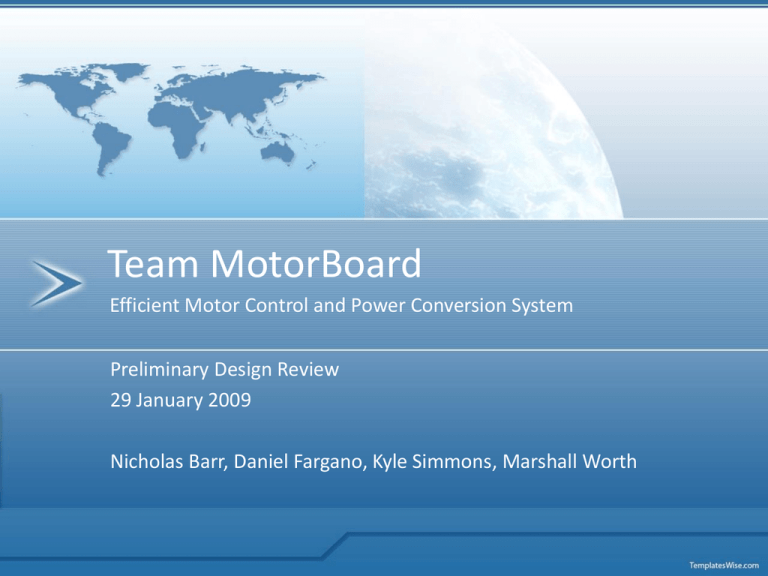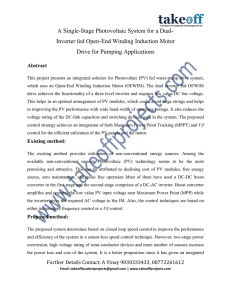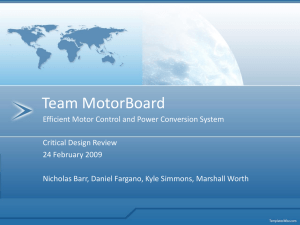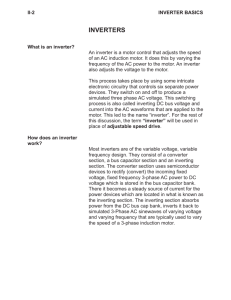(5.8 MB PowerPoint)
advertisement

Team MotorBoard Efficient Motor Control and Power Conversion System Preliminary Design Review 29 January 2009 Nicholas Barr, Daniel Fargano, Kyle Simmons, Marshall Worth Project Summary Design and prototype an efficient motor control and power conversion system to interface between a 200VDC source and an AC induction motor for both driving and generating power stages Project Purpose Comply with IEEE Future Energy Competition requirements 1 kW motor 3000 RPM cruising speed 200 Volts DC source 75% efficiency as a motor (3000 RPM) 75% efficiency as a generator (3000 RPM) Locked rotor torque of 30 N-m, for duration of 3 to 5 seconds Initial load of 30 N-m and reach the speed of 3000 rpm within 3 to 5 seconds Quickly and safely become an alternator Project Purpose Produce a viable option for industry Quick and efficient interface for generating and driving Possible application in hybrid vehicle motor drives Cheap and easy way to get a 3-phase, high power pure sign wave IEEE/APEC Dan and Kyle will be going to Washington D.C. Feb. 13th – 17th Presenting IFEC progress report to IEEE Attending Applied Power Electronics Conference Power Converters Motor Drive Efficiency Motor 3 HP, 3600 RPM general purpose motor Baldor 84% efficient at 3600 rpm System Diagram Control System Control System LPC-P2148 Olimex devo board NXP LPC2148FBD64-S Program Memory Size:512KB RAM Size:40KB Package / Case:64-LQFP Speed:60MHz Core Processor:ARM7 Data Converters:A/D 14; D/A 1 Core Size:16/32-Bit Interface:I²C, SPI, SSP, UART, USB Sensors 3 Hall-effect current sensors for a,b,c line detection Quadrature encoder (fancy shaft encoder) Most likely optical Prefer absolute position sensor DC line voltage sensor Optional (safety): Temperature sensor Control Algorithm The objective of the controls algorithm is to sense a set of inputs from the motor and control board and produce a corresponding 3-phase output voltage. First we sample the current in phase A,B and C as well as the position and speed of the rotor shaft Second we determine the motor operating mode, motoring or generating, and the desired speed of operation. From these quantities the desired DC-DC converter output voltage and phase A,B and C voltages are calculated. Finally the controller will determine the appropriate duty cycle to emit on the IGBT gate driver input in order to produce the desired voltage at both the output of the DC-DC converter as well as the phase A,B and C voltages produced by the inverter. Power System 195VDC line to supply from Veriac Large DC supply line capacitor Input from control Bidirectional Buck-Boost Converter Input from control Bidirectional DC 3- phase AC inverter Power System Simulated 3 Phase Waveforms Test Methodology – Converter Specifications: 95%+ efficiency DC input to Bucked/Boosted DC output Test: At specific duty cycle and input voltage -> Measure and Compare Output voltage to theoretical output voltage determined by the conversion ratio M(D)= -D/(1-D) Swing the input voltage at specific duty cycle to confirm it works for various voltages Change the duty cycle and repeat the voltage swing to ensure the converter works at all duty cycles and voltages If either of the test specifications is not met the inverter must be checked against the schematic design of converter to ensure all components are properly placed and have solid connections. Test Methodology – Inverter Specifications: 95%+ efficiency DC input -> 3 phase AC output Test: Swing input voltage and monitor output. Peak AC voltage should be no less than 75% of the DC value At each voltage level, check for clean sinusoidal AC signal and that all 3 phases are 120 degrees apart If either of the test specifications is not met the inverter must be checked against the schematic design of the inverter to ensure all components are properly placed and have solid connections. Test Methodology – Controls Specifications: Control the gates of both the converter and inverter Test: Use a logic analyzer to make sure we are getting the correct signals on the output terminals We will connect the controls to the inverter and converter to see if it will actually control the gates of the transistors If the controls are not working, use the logic analyzer to check the entire board to make sure all signals are producing correct signals and check it against the schematic to ensure the accuracy of the controls. Marketability Society is going green energy conservation Makes for more efficient use of the power Perfect addition to hybrid vehicles Many companies are focusing on hybrid-electric drive systems but are lacking bi-directionally, specifically the generation of power This could serve as a quick fix or serve as a prototype for future drive systems Environmental Impact & Impact on Society Shift in attitudes is moving interest towards electric vehicles Increasing ease and efficiency of battery to motor interface might allow quicker to-market designs Manufacturing of board can be done in a manner which reduces impact on environment (RoHS) Sustainability Many of the parts we will be using in our project are accessible through multiple vendors at low cost. There are no specialty components that would limit us or this project to purchase from any specific vendor. Motor designed for is very common Electric motors will always be used, independent of their use in vehicles The most likely component to fail would be the IGBTs on the inverter which could blow if we don’t account for current spikes in the switching. Manufacturability Will need to meet FCC/RoHS standards Easy to debug due to breakout pins The tolerances on the components shouldn’t be that big of an issue for this project. We are aiming to have an efficiency of at least 75% which will rely heavily on our designs of the power electronics and the motor itself but for individual components the tolerances of typical resistors, capacitors, inductors, etc should be adequate for our needs. Costs of Manufacturing Should be relatively cheap and marketable/profitable $50 for controls $40 for power components $20-$30 for sensors/power/etc Safety Potentially dangerous due to high current/voltage No user access to switching Design for shock resistance Proper grounding High voltage isolation from low voltage controls Division of Labor Converter Hardware Buck Boost Marshall Nick 3 Phase Inverter Kyle Dan Controls Software Marshall Nick Propagation Kyle Dan PCB Design Nick Kyle Testing/Verification All Text All Presentation All Project Milestones CDR- part selection/bought, system schematics, basic power system and basic microcontroller functionality Milestone I - all hardware working on protoboard, sensors configured and working, and final revision of PCB completed and sent out Milestone II – working prototype, PCB built and populated EXPO – final debug, packaging, documentation done Schedule Overview Buck-Boost Converter: Jan 19-Feb 19 DC:AC Inverter: Jan 19-Feb 19 PCB layout: Feb 20 – March 11 Software: Feb 20 – April 6 Project Completion: April 16 Money Primary Funding: Fall 2008 EEF mini-proposal applied for and received ($2k) Spring 2009 UROP Funding ($1k) Secondary Funding: Prize money from the IFEC 2007 competition (~$3k) This money needs to cover the motor design team as well Department funding from Lightner ($5k) Backup Funding: Professor Barnes has a large grant for student research projects ($10k+) Budget Item Quantity Total Cost PCB Fabrication 2 $150 Microprocessor 1 $15 Controls parts 2 $60 IGBTs 15 $375 Drivers 4 $30 Power Electronics parts ? $20 Sensors 4 $50 Packaging 1 $100 Printing/Poster/etc 1 $75 Shipping $90 Total $965 Risks and Contingency Plan Lack of proper efficiency Focus on driving side, less emphasis on generating Hand wired motor Current spikes Designed to have peak current double what we expect Most parts interchangeable with higher rated components PCB fabrication problems We can wire wrap or use devo board Questions?






